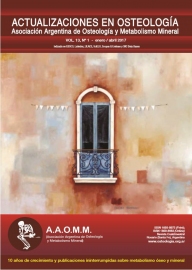Evaluación de la respuesta densitométrica en pacientes con osteoporosis posmenopáusica tratadas con ranelato de estroncio o denosumab
Autores: Ariel Sanchez, Lucas R. Brun, Helena Salerni, Pablo R. Costanzo, Laura Maffei, Valeria Premrou, Marcelo Sarli, Paula Rey, María Silvia Larroudé, María Lorena Brance, Ana Maria Galich, Diana C González, Alicia Bagur, Beatriz Oliveri, Eduardo Vega, María Belén Zanchetta, Vanina Soledad Farias, José Luis Mansur, María.S. Moggia, María M. Pavlove, Silvia Karlsbrum
Resumen
Tanto el ranelato de estroncio (RSr) como el denosumab (Dmab) son eficaces en el tratamiento de la osteoporosis (OP) posmenopáusica (PM). El efecto de cada fármaco por separado sobre la densidad mineral ósea (DMO) ha sido estudiado recientemente. Con ambas drogas se observó, al año de tratamiento, un aumento significativo de la DMO en columna (CL), cuello femoral (CF) y cadera total (CT). En este trabajo comparamos la respuesta densitométrica al año de tratamiento con una y otra droga. Utilizamos los registros de 425 pacientes PM tratadas con Dmab y 441 tratadas con RSr. En cada paciente analizamos el porcentaje de cambio; se clasificaron como respondedoras aquellas que mostraron un cambio 3%. Adicionalmente se comparó la respuesta en pacientes no previamente tratadas con bifosfonatos (BF-naïve) en comparación con pacientes que habían recibido previamente un BF. Al analizar el grupo completo para Dmab, el porcentaje de pacientes respondedoras fue de 68,4% en CL, 63,3% en CF y 49,3% en CT. Por otro lado, en el grupo de pacientes tratadas con RSr, el porcentaje de respondedoras (53,8% en CL, 40,0% en CF y 35,6% en CT) fue estadísticamente menor. Cuando comparamos la respuesta entre las pacientes BF-naïve que recibieron RSr o Dmab, el Dmab indujo mayor respuesta en CL y CF que el grupo RSr, sin diferencias en CT. Cuando se analizaron los subgrupos BF-previo, las tratadas con Dmab mostraron mayor respuesta en todas las regiones. Conclusión: en pacientes con OP-PM, el tratamiento con Dmab produjo mayores incrementos densitométricos que el RSr, siendo el porcentaje de pacientes respondedoras mayor con Dmab que con RSr.
Palabras clave: osteoporosis posmenopáusica, ranelato de estroncio, denosumab, bifosfonatos, respondedores.






